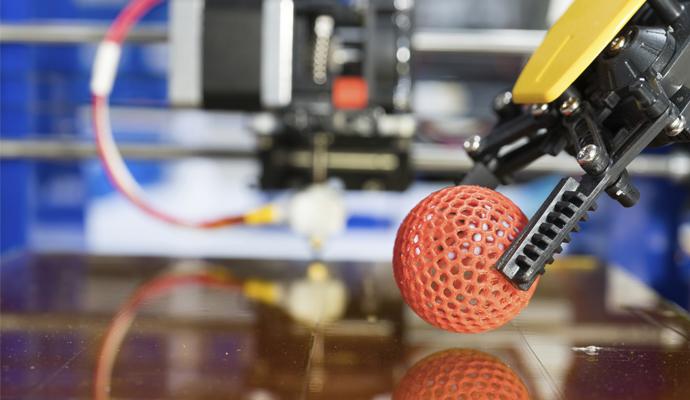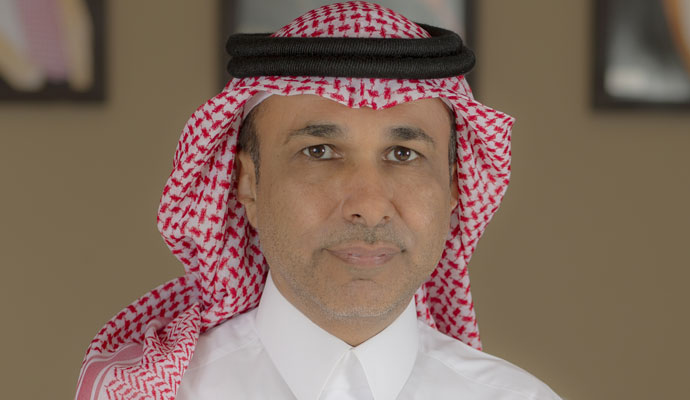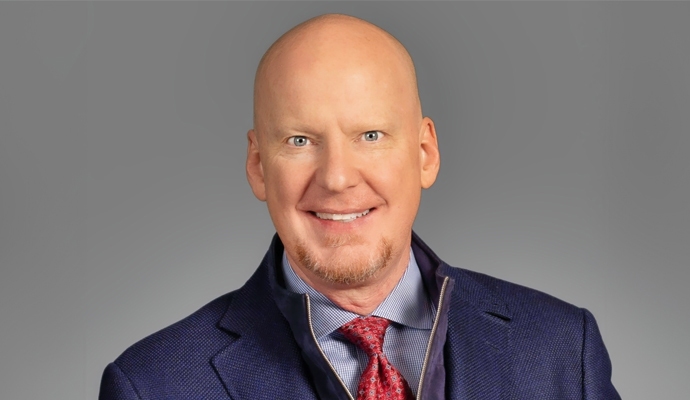STMicroelectronics: The Metaphysics of a Metanational Pioneer
From a two-country merger to a 27-nation powerhouse, the semiconductor company is a paradigm of the borderless entrepreneurial giant.
(originally published by Booz & Company)
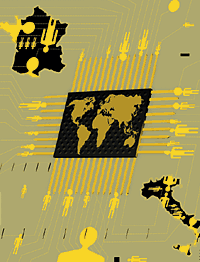 |
|
Illustration by John Hersey |
A metanational is a large, entrepreneurial multinational that is able to tap into hidden pockets of innovation, technology, and market knowledge scattered around the world, especially in underexploited emerging markets, according to Yves Doz, the Timken Professor of Global Technology and Innovation at INSEAD, José Santos, and Peter Williamson, both also of INSEAD. The trio, authors of From Global to Metanational: How Companies Win in the Knowledge Economy, says ST is one of a handful of such companies they were able to identify from a five-year study of 36 international companies, a dozen each from the U.S., Asia, and Europe.
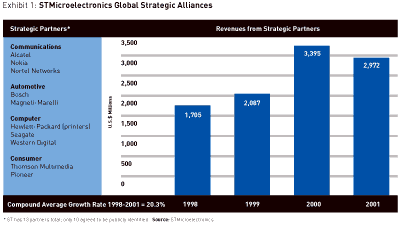
To be sure, the lessons learned at ST from the special challenges of marrying French and Italian cultures and competing in the volatile semiconductor business are an important part of its story. However, ST’s accomplishments stand out most in its validation of the “centerless” corporation organizational model, which is based on minimizing overhead and hierarchy while pushing critical decision rights to the periphery. ST’s success also demonstrates the value of having a constellation of strategic alliances with market leaders in multiple businesses, building upon knowledge acquired from partners all over the globe, and disseminating that knowledge internally so it can be used effectively throughout its own organization.
A Surprise Showing
The 1987 union of SGS and Thomson was a natural fit. Although both companies had advanced technology and seasoned management, as separate entities they lacked scale and could never achieve sustained profitability if they did not move beyond their domestic markets. Italy and France together represented only 5 percent of the world semiconductor market, hardly a robust foundation for growth.
In 1987, no one could have predicted how fast STMicroelectronics would eventually grow. (See Exhibit 2.) Postmerger, the first year was rocky: The combined company ranked a dismal 17th in chip sales. That year, ST lost $200 million on sales of $859 million.
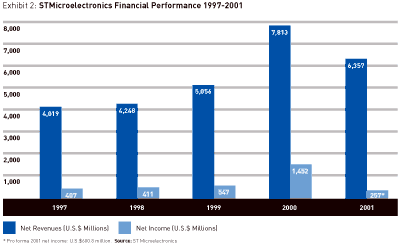
But the new company also had some hidden virtues. ST’s inclination to partner — its highly visible strength today — surfaced before the merger, when SGS and Thomson worked together in a strategic alliance to develop and produce so-called nonvolatile memory, a type of chip that retains data even with the power switched off. This strategic alliance created a growth product that commanded a premium, but, what was even more significant, the experience demonstrated that the French and Italian teams could work together. Furthermore, upper management at both SGS and Thomson had earned their stripes at such big U.S. chip companies as Texas Instruments Inc. and Motorola Inc. This helped create a common mentality from the start.
Equally important to the combination’s future was ST’s deep expertise in analog technology, the devices that process continuous electronic signals rather than the ones and zeros of digital technology. An apparent bridge back to the predigital days, analog was actually a path to a vibrant future.
In the 1980s, when the world was going digital, most large U.S. and Japanese chip companies abandoned the manufacture of analog chips because desktop PCs, the growth market then, used relatively few of them. But analog chips are required to manage power, radio frequency transmission, sound, and graphics. The proliferation of cellular telephones, wireless computers, and consumer electronics products like DVD players created a resurgence of demand for analog devices in the 1990s, which ST was well positioned to exploit. Just as Intel drove the microprocessor revolution in the 1980s by combining most of the digital devices needed for computation on a single chip, ST saw an opportunity to combine analog functions, such as sound, graphics, and power management, together with digital circuitry, such as logic and memory, on a single chip.
Entering the 1990s, mixed analog and digital devices like this “system-on-a-chip” presented a huge market opening that few other companies could address. “Very early, when the company was founded, we understood our market was moving to system-on-a-chip,” says Alain Dutheil, ST’s corporate vice president for strategic planning and human resources.
Today, ST has a diversified customer base among manufacturers in consumer electronics, telecommunications, computer peripherals, automobiles, and smart card/security devices. It is also a primary supplier to companies in the fast-growing electronics contract manufacturing sector.
ST’s system-on-a-chip technology is now ubiquitous, if invisible to the average consumer. A wealth of products people take for granted — pocket-sized televisions, MP3 players, DVD players, multimedia cell phones — are possible only because of mixed analog/digital chips, the lion’s share of which are sourced from ST. One of every two cars on the road contains at least one ST chip, and that number will only grow as customers demand more electronic devices in their automobiles, whether GPS or voice-activated climate control. So great has the percentage of ST content become in some branded consumer products that many of the company’s best customers decline to discuss it.
For all its strong positioning in analog technology, ST quickly recognized it could not exploit its advantage in the system-on-a-chip market through traditional arm’s-length relationships with its customers. “You need to put together the silicon know-how, which we had, with the system know-how, which the customer had,” says Mr. Dutheil. “Fifteen years ago there was a clear border between the two, but they had to come together on a chip. In the past, there was a buy-and-sell relationship, but now we have to codesign the product. We have to be willing to exchange technology. Now that’s quite obvious; 15 years ago it was not.”
Novel Customer Alliances
ST was compelled to partner early and intimately with consumer electronics manufacturers in order to convince customers to replace their complex circuit boards with its system-on-a-chip. Recalling that would-be customers would ask — seriously — whether Italy even had a semiconductor industry, Andrea Cuomo, ST’s corporate vice president for advanced system technology, says, “The fact is, we had to listen to customers” to attract business. That willingness to listen led directly to the system-on-a-chip concept, and undergirded a collaborative culture that has maintained ST’s market leadership. “Every time we can deliver a solution to a customer problem we get an advantage, but this doesn’t require us to be a technical ayatollah,” says Mr. Cuomo.
ST entered early alliances in consumer electronics and telecommunications with Thomson multimedia and Alcatel in France, which prospered. But senior management knew the real growth opportunities lay outside the country. The first truly big alliance win came with the Seagate Corporation, the world’s leading maker of disk drives, which is based in Scotts Valley, Calif. The assignment: to shrink all the components of Seagate’s hard disk drive controller board onto one or two custom chips.
The payoff for Seagate was a vast reduction in its drives’ size, cost of production, and power consumption. Smaller, cheaper, less power-hungry drives allowed Seagate to enter entirely new markets, such as laptop computers and handheld devices. ST gained a loyal strategic partner, and today Seagate remains among its largest customers. ST also demonstrated in this alliance that it had both the technological and the managerial capacity to integrate complex solutions for a customer halfway around the globe.
Customers say ST has handled well the possibility of conflict of interest. “We have, and we believe ST has, fairly good firewalls between design teams,” says Rob Ryan, manager of power chip engineering at the Western Digital Corporation, another major disk drive manufacturer, which is based in Lake Forest, Calif. ST, he says, does “a pretty good job keeping proprietary things proprietary. I bring them into the lab. We’ve educated them about how to make a drive, and they’ve educated me about their process, so I can tailor the design to their expertise.”
In disk drives, ST supplies critical components, but drive manufacturers add considerable value themselves, with constant improvements in disk technology. For many other products, however, ST’s system-on-a-chip has replaced essentially all of the components manufacturers formerly assembled themselves. In car radios, for example, ST supplies a complete system to nearly all of the leading automotive manufacturers, which now differentiate their products primarily by brand name, features, and faceplates.
Clearly, a combination of technology and strategy has allowed ST to capture a large percentage of the value in many markets it serves. But the company’s growing importance to many of its customers has forced a sea change in the very structure of the supplier/customer relationship. In other words, the architecture of the product, which spurred the growth of customer partnerships, has altered the architecture of the company; it has even redefined roles for ST executives. For example, Otto Kosgalwies, ST’s vice president for European sales and marketing, is leading a corporate initiative in supply chain management. The combination is not as odd as it sounds, he says. “Today there’s not the classic purchase order. There’s a contract, and we have to manage the deliveries. There’s constant feedback, so the customer more or less drives our supply chain.”
Such a transparent process requires a great deal of openness where none existed before, Mr. Kosgalwies says. “In the past, the customer issued a purchase order he didn’t understand, and received a confirmation he didn’t understand. Now we have an open door policy, sharing information you never used to share. It used to be absolutely unheard of to tell the customer your own component inventories. Now it’s standard for us.”
ST has to share component inventories with customers because in many cases it is the sole supplier of a chip that may be 90 percent of the finished product’s technology content. Without the ST chip that controls the print head, Hewlett-Packard cannot sell its printers; without the radio frequency chips supplied by ST, Nokia cannot sell its cell phones; without ST’s system-on-a-chip, Scientific-Atlanta’s set-tops are hollow boxes. This kind of single sourcing used to be rare, but today it is mandated by the high degree of custom design and proprietary manufacturing processes in ST’s products.
Virtues of Virtuality
Close cooperation and sole sourcing of critical components also requires ST’s customers to make structural and cultural changes. Companies that once prided themselves on their vertical integration or the depth of their engineering capability now depend on working with ST for their systems design, manufacturing, and even packaging.
Change can be especially trying for many of the companies ST serves because their market success has long been predicated on technology leadership. Sharing proprietary information with, and outsourcing systems development to, a supplier like ST does not come naturally to them. That’s why ST pursues a gradual approach to partnerships, creating confidence by increasing both the percentage of ST content in the customer’s product and the closeness of the relationship over years.
Partners prefer this gradual approach, too. For Nokia, ST has been elevated over a period of 10 years from what the Finnish cell phone giant deems a simple supplier, to a premier supplier, to a partner; ST is one of only 10 such partners. ST supplies Nokia with both the radio frequency circuitry, which is the core of a cell phone, and the power management system, which is critical to battery life — a major differentiator in Nokia’s market. Over years of working together, the two companies found they had compatible cultures and values, which, in turn, enabled them to set long-term goals and follow operating principles together.
“We both understand that we can set objectives as a virtual company that will be greater than if we have a supplier/customer relationship,” says Jean-François Baril, Nokia’s senior vice president for sourcing and procurement. “We establish objectives in technology, quality, and cost that are bigger than our own simple interest, in the spirit of one plus one equals three. This is not so easy if you are a short term–oriented company. If you are a long-term company, it is very strong.”
A governance committee formed of senior executives from Nokia and ST meets quarterly, like a virtual board for the virtual company, and the partnership’s performance is evaluated just as if it were an independent company. Jorma Olilla, Nokia’s chief executive officer, and Pasquale Pistorio, ST’s president and chief executive officer, meet twice a year to make sure the strategic alliance remains in alignment with objectives. But there are more frequent meetings of teams from both companies in development, marketing, and sourcing. Their roles are just as important. “You need to start with top management, of course, but you must also go right down to the basic designers,” says ST’s Alain Dutheil. “You need to create confidence.”
Nokia and ST have regularly scheduled “dream days,” when engineers from both companies get together to create wish-list products, without interference from management or marketing executives. “Our engineers get excited by what ST can provide. Then we align peer-to-peer communication,” says Mr. Baril. “It’s really from the core, or the DNA, that we see the need to align.”
Personalizing customer relationships also helps make them work. “It’s a special relationship with a few guys who have demonstrated that in difficult times, people are able to help each other. Two years ago, the world was running short in terms of capacity, and ST treated us very, very nicely,” recalls Mr. Baril.
Flexibility is also a key to maintaining strategic alliances. “Quite often we are asked how does it work, and the answer is, the way the customer wants,” says Mr. Dutheil. “We go as far as they want us to go, whether it’s common design teams, at their facility or ours, employee information, access to technology, or priority access to manufacturing.”
Another factor in ST’s ability to partner is the company’s status as a pure-play chipmaker. Unlike Motorola or many of the large Japanese semiconductor manufacturers, ST has no finished-goods business that might compete with its customers. And at a time when many chip companies have gone “fabless” (meaning they have outsourced manufacturing altogether), ST retains a major strategic advantage through its ability to supply customers with complete solutions. Some of its partners have gone so far as to sell off their internal semiconductor manufacturing because they can depend on ST’s efficient production.
As a way to maintain its manufacturing edge, the company has joint development agreements with its own suppliers — such leading equipment makers as Applied Materials and Canon Inc. Through these alliances, ST’s engineers are able to ensure that solutions to their needs are designed into succeeding generations of manufacturing equipment. “When you are in the technology race, you are forced to buy machines that are not mature, so partnering with suppliers is becoming more and more vital,” says Orio Bellezza, group vice president for operations and technology. “There is still a lot of value in the way you manage manufacturing. The machines are standard, but there is room for differentiation in how you use them.”
Although ST plans to form more alliances, particularly in Asia where it has very few, the total number will remain small, so that each receives the necessary attention, Mr. Dutheil notes.
Partner and Prospector
ST’s network of strategic alliances contributes more than revenues to the company. The alliances also have helped the company access and assimilate complex knowledge from disparate sources. For a chip company created far from the talent pool of Silicon Valley, this is a core competency and a major source of differentiation.
“ST really benefited from being born in the wrong place,’’ says Professor Doz of INSEAD. “Lacking the depth of local technologies and market understanding around its birthplaces in France and Italy, ST had to source a great deal of specialist knowledge from outside its home.”
Metanationals like ST that scan the world for competitive knowledge are global “prospectors, not projectors,” says Professor Doz. Traditional multinationals are projectors, he argues, because they project their own business formulas and standards around the world, the way Intel projected its X86 microprocessor design, turning it into an industry standard by virtue of its incorporation in the original IBM PC. Although Intel may manufacture in a foreign country to reduce labor costs, it tends not to look for innovation outside Silicon Valley. This is not a criticism of Intel, the world’s most successful chip company, but as competitors like Advanced Micro Devices Inc. and the Cyrix Corporation have discovered, it is not an easy model to emulate.
In contrast to Intel, ST, an emerging prospector, produces a plethora of nonstandard chips, which differ materially from one customer to the next. Rather than project a standard for others to incorporate in their products, ST captures technology from multiple sources and incorporates it in a system-on-a-chip tailored for a specific customer, or set of customers. And when ST sets up manufacturing in a country, it also adds engineering and marketing capabilities. A key role of these business units is to maintain ties with local universities, for both recruiting purposes and technology transfer.
In the beginning, there surely was an element of necessity in ST’s emphasis on learning, just as there was in its reliance on alliances. But ST has made a learning culture central to its strategy, and has institutionalized the learning process to a rare degree. Learning at ST is both a continual, distributed process, in which the company seeks innovative thinking wherever in the world it is based, and a more formalized and central process, with its in-house ST University offering classes at campuses in the south of France, Sicily, Singapore, and Phoenix, and at all of the company’s plants around the world — classes that every employee must attend.
Like all chip companies, ST has moved labor-intensive assembly processes (so-called back-end operations) to developing countries like Morocco and Malaysia. But to a limited extent, it has also moved higher-value activities, like product development, to emerging markets. If properly cultivated, these countries can be a source of both new customers and new ideas.
“SGS was the first Western company to set up front-end operations in Singapore in 1983,” says Carmelo Papa, a corporate vice president and chairman of the emerging markets task force. “We were the first to understand that it was not only a place to find cheap labor.’’ Now, in almost every country in which ST operates, the local organization has a sales force, as well as designers and technical support people who develop products for the local market.
Like many technology companies, ST is expanding in India, where it has established, near New Delhi, one of the company’s most important R&D centers. ST India was recently named one of the “25 Best Companies to Work For” in a joint survey of 205 companies across 15 industries conducted by Hewitt Associates, a global human resources consultancy firm, and Business Today, the leading business publication in India.
India is attractive as much for its engineers as for its growing market and low labor costs, says Mr. Papa. “Every market should not only be a market for consumer electronics, but also a provider of brains for the future. While India is not very good at manufacturing yet, they have plenty of brains. Instead of moving them to the United States, we will move there.”
When ST identifies a need, or something lacking in its knowledge, it moves quickly to place people where that knowledge can be found. After identifying a professor in Hong Kong with expertise in a particular emerging field, the company hired two people in Hong Kong to work with and learn from him.
As the company opens itself up to learning from sources everywhere, unusual ideas can appear from unexpected places. “Each year we award the best suggestions, wherever they come from,” says Carlo Ottaviani, group vice president for corporate communications. In one case, a woman working in Morocco used ST’s Total Quality Management (TQM) system to suggest a way to improve the bonding of the semiconductor assembly operation, drawing on her experience using a sewing machine. The bonding step of the semiconductor manufacturing process is the phase in which the die, already positioned on the frame (and pins), is linked to the outside by thin gold or copper wires connected to the pads. This operation is very similar, and visibly so, to what a sewing machine does. The concept was accepted, and the woman received one of the awards for Best Suggestion of the Year.
These awards are considered great honors and are presented in person by Mr. Pistorio, the CEO, or Mr. Dutheil, typically in Geneva or Nice, France. “These are people whom one might overlook as being able to innovate in a high-tech industry. In reality, they are innovating every day, improving the most high-tech machinery,” says Mr. Ottaviani.
The customers of its customers are another source for learning that ST seeks to leverage. For example, to get a sense of demand for TV set-top boxes, ST talks to cable operators, not just its customers, the manufacturers of the devices. Some of the learning is seemingly out of left field: ST learned from consumer electronics retailers that DVD players for the Brazilian market must include karaoke, or they will not sell.
“Very often we visit Daimler, BMW, and Ford, or they visit us,” says Paolo Gonella-Pacchiotti, director of ST’s car multimedia business unit. “It’s important for us to understand what carmakers want, although we are going to sell the product to the component manufacturers, like Bosch, so that we can help them meet the requests of the car manufacturers.”
The knowledge gained from such visits enables ST to achieve design wins for products that have never existed, except on some engineer’s wish list, such as the single-chip telematics system combining GPS, voice recognition, and wireless communications that the Italian electronics manufacturer Magneti-Marelli now supplies to automakers Alfa Romeo and Fiat.
A Centerless Corporation
The marriage of SGS and Thomson was described, and accounted for, as a merger of equals. The company, initially named SGS-Thomson Microelectronics, changed its name to STMicroelectronics in 1998. For a time, ST maintained dual headquarters, in Paris and Milan. Dual locations rapidly proved impractical, but settling on one or the other of these sites guaranteed to offend half of the new company. So a compromise was reached by moving corporate headquarters to Geneva, Switzerland, where it occupies a few floors in a nondescript office building near the airport.
Although some executives still grumble that this solution merely succeeded in making French and Italian employees equally unhappy, it also helped create a company with a very lean corporate infrastructure. The Geneva office is spare and sparsely populated, and even those executives who call it home are almost never there. They may be in Agrate, Italy, near Milan, on a large campus that combines Silicon Valley–style metal and glass with the decades-old concrete headquarters of ST’s state-owned predecessor. Or they may be at the company’s other big campus in Crolles, France, near Grenoble. But they are just as likely to be in Russia, Turkey, Brazil, or China because these markets are not just outposts, and the company’s facilities in them are ST’s real functional core.
“The way we think about globalization is strategic, to have an integrated presence in all the major markets: R&D, sales and marketing, manufacturing,” says Mr. Dutheil, the chief strategist. “Technology R&D is centralized in Crolles and Agrate; product development is dispersed. Because product design must be close to the customer, we have dispersed it all around the world.”
One of the ways ST coordinates development efforts across multiple geographies is through the use of virtual teams. Linked by e-mail, Web-based collaboration tools, and teleconferencing, employees need not share a location to share a project. In winning the Magneti-Marelli telematics contract, for example, ST drew on team leaders based in France, England, Italy, India, and, in the U.S., California and Arizona.
The team members spanned 14 time zones and spoke six languages.
“There was no way ST could achieve what it had to do through traditional hierarchical command-and-control management,” says Jon Katzenbach, founder and senior partner of Katzenbach Partners LLC and coauthor of The Discipline of Teams: A Mindbook-Workbook for Delivering Small Group Performance. “These folks had to be gathered into a team, and the time, personnel, and cost factors were too great to assemble them in one place. In a team, there’s an element of trust and the ability to discuss problems without the fear of misinterpretation. You put those things out over the Internet and it can be a problem. Those are the kinds of challenges that are particularly difficult to overcome, and that’s what the ST team was particularly good at handling,” he says.
Of course there is a price to be paid for working this way. The cell phone can ring at any time, day or night; the business-class lounge in Singapore or Santiago becomes your office. Carmelo Papa, the emerging markets expert, has trained himself to sleep in three-hour shifts, even at home in Geneva, because he never has time to adjust for any single time zone. “It’s a way to survive,” he shrugs. “My body has adapted.”
But Mr. Papa says it is essential to maintain operations in all major markets, even if it results in a more complex organizational structure. “You have to understand different mentalities. That’s the tough thing. Doing business in Brazil is not like doing business in India. You have to respect the local mentality without forgetting the rules of business that apply everywhere,” he says.
ST achieves alignment across multiple geographies and business models by sharing learning and experience at ST University, and by adhering to core company practices, such as a commitment to environmentally sound manufacturing, throughout the world. But the company also acclimates itself rapidly to changing market conditions and different operating environments. “Very often you have some ideal concept of an organization in the mind of the managers, and then they have to adapt that to the reality of the business,” says Mr. Dutheil. “We are doing that every day.”
ST’s distributed infrastructure also proved an advantage in the market disruption that followed the terrorist attacks in the United States in 2001. “During the three or four weeks following 9/11, we were of course very concerned,” says Mr. Dutheil. “Could we get product, could we ship product? Frankly, we found our organization reacted very well because we are not dependent on the U.S., not dependent on one segment, one product family, or one geography. We were able to ship from Europe or Singapore. Our global infrastructure worked very well for us. It is a real plus not to be centered in any one place.”
Another benefit of operating with a lean central organization is that ST was able to avoid the mass layoffs and losses that most semiconductor companies endured during the industry downturn of 2001. And because of ST’s diversification across industries and geographies, even as the chip market fell by 32 percent in 2001, ST declined by just 18 percent and remained profitable. The company also gained market share during the downturn and emerged a stronger competitor.
“For 18 months, business was booming, up 40 to 50 percent, and then suddenly, overnight, the market went down,” says Jean-Philippe Dauvin, the company’s chief economist. “For six months, bookings were almost zero, but we had to maintain motivation, so we would be ready when things accelerated again. In the market downturn, many companies changed strategy. We at ST didn’t change our strategy or our portfolio; we adapted.”
Part of Mr. Dauvin’s job is communicating with securities analysts, and he has added a special course for them at ST University so that they understand the company’s methods and metrics. Nevertheless, analysts pose a special challenge to this company that has grown so fast from a small regional player to a global leader.
“I’m not sure U.S. investors understand us very well,” Mr. Dauvin says. “They continue to think we are the biggest of the pygmies. But No. 3 is not a pygmy.” ![]()
|
Seven Lessons from an Emerging Metanational |
|
1. Multinationals project standard business formulas globally. Metanationals scan the globe to create nonstandard offerings. 2. Emerging markets are sources of fresh insights and innovation, not just areas for lower-cost labor and sales growth. 3. Global learning requires formal training and education and a continuous learning culture that supports corporate strategy. 4. A network of strategic partner alliances helps to access and internally assimilate complex knowledge from disparate sources. 5. Truly strategic partnerships require an unprecedented level of candor, trust built over time, and continual communication. 6. A centerless corporation minimizes the head office; strategic functions — R&D, sales and marketing, and manufacturing — are spread across major markets. 7. Decision rights are given to managers who are closest to key markets, customers, and strategic partners. |
Reprint No. 02309
| Authors
Lawrence M. Fisher, lafish3@attbi.com, covered technology for the New York Times for 15 years and has written for dozens of other publications. Mr. Fisher, who is based in San Francisco, is a recipient of the Hearst Award for investigative journalism. |


